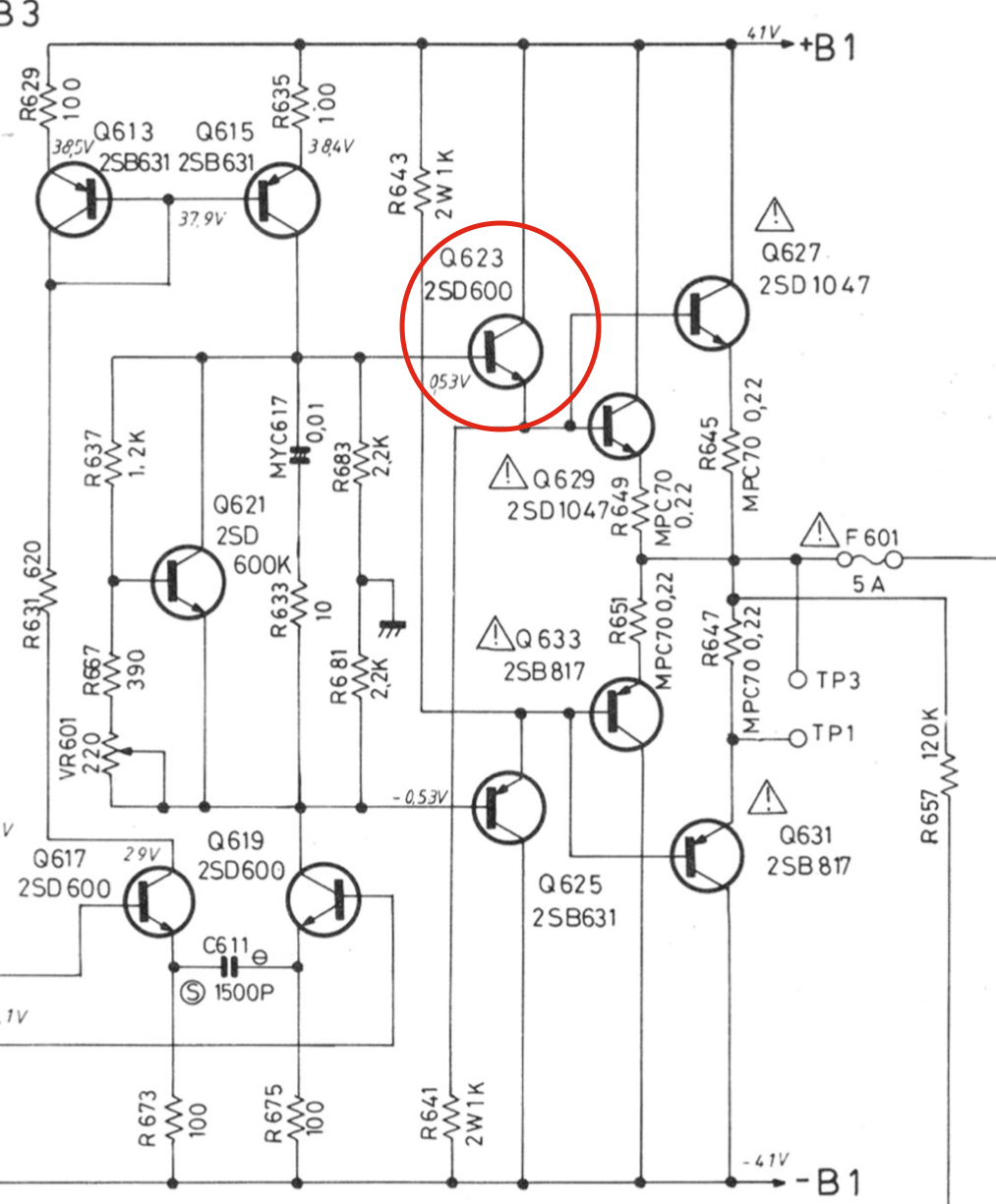Hi,
A Rotel RA-840BX4 amp I am working on seems to be more or less OK, except that one of the drivers is running hot, hotter that the others. Each channel has two drivers (running in class A). The heatsink of three drivers warm up to about 55 degrees C, but one (Q623) warms up to over 70 degrees C.

I checked R641 (and R643) and they both measure the expected 1K ohms. Replacing Q623 (I had a spare) didn't help.
Does it make sense to suspect the current mirror and / or Q635? What are good equivalents for a 2SB361? Of course, I will replace them both.
Or perhaps any other suggestions?
Much appreciated!
René
A Rotel RA-840BX4 amp I am working on seems to be more or less OK, except that one of the drivers is running hot, hotter that the others. Each channel has two drivers (running in class A). The heatsink of three drivers warm up to about 55 degrees C, but one (Q623) warms up to over 70 degrees C.

I checked R641 (and R643) and they both measure the expected 1K ohms. Replacing Q623 (I had a spare) didn't help.
Does it make sense to suspect the current mirror and / or Q635? What are good equivalents for a 2SB361? Of course, I will replace them both.
Or perhaps any other suggestions?
Much appreciated!
René
Last edited:
Hi,
A Rotel RA-840BX4 amp I am working on seems to be more or less OK, accept that one of the drivers is running hot, hotter that the others. Each channel has two drivers (running in class A). The heatsink of three drivers warm up to about 55 degrees C, but one (Q623) warms up to over 70 degrees C.
I checked R641 (and R643) and they both measure the expected 1K ohms. Replacing Q623 (I had a spare) didn't help.
Does it make sense to suspect the current mirror and / or Q635? What are good equivalents for a 2SB361? Of course, I will replace them both.
Or perhaps any other suggestions?
Much appreciated!
René
First check for DC offsets on your output (TP3).
Then check the voltage at the base of Q623.
Also recheck the Bias per the attached thumbnail.
Attachments
Last edited:
Thanks for your thoughts.
I did some checkings: Q627 and Q629 both measured fine.
There was some DC offset on this channel (~30mV, the other channel was fine, approx. 0mV) which I corrected. Bias was at approx 2.5 mV, as suggested.
The base at Q623 was at 1.18 V (compared to TP3). The equivalent on the other channel measured the same (but the schematic suggests it should be 0.53 V?).
However, measuring the temperature again, the situation appeared less asymmetric than before: Q637 was ~ 71 C, equivalent on the other channel ~ 67 C. The other two drivers were ~ 55 C.
Perhaps nothing to worry about?
I did some checkings: Q627 and Q629 both measured fine.
There was some DC offset on this channel (~30mV, the other channel was fine, approx. 0mV) which I corrected. Bias was at approx 2.5 mV, as suggested.
The base at Q623 was at 1.18 V (compared to TP3). The equivalent on the other channel measured the same (but the schematic suggests it should be 0.53 V?).
However, measuring the temperature again, the situation appeared less asymmetric than before: Q637 was ~ 71 C, equivalent on the other channel ~ 67 C. The other two drivers were ~ 55 C.
Perhaps nothing to worry about?
Last edited:
Thanks for your thoughts.
I did some checkings: Q627 and Q629 both measured fine.
There was some DC offset on this channel (~30mV, the other channel was fine, approx. 0mV) which I corrected. Bias was at approx 2.5 mV, as suggested.
The base at Q623 was at 1.18 V (compared to TP3). The equivalent on the other channel measured the same (but the schematic suggests it should be 0.53 V?).
However, measuring the temperature again, the situation appeared less asymmetric than before: Q637 was ~ 71 C, equivalent on the other channel ~ 67 C. The other two drivers were ~ 55 C.
Perhaps nothing to worry about?
If you measured from Q623 base to TP3 part of the voltage drop would be due to the dc offset.
I take it you used the diode test function to check Q627 and Q629 base emitter junctions and the voltage range to test between base Q623 to TP3 under power without the speaker being connected.
I would be comfortable with driver temperature at 55 C if that applied to all 4 of them. I recommend measuring the voltage drops across all the emitter resistors in the driver and output stages and work out the current levels.
The safest way to do that is to put the black probe into the black speaker terminal in that way you only have to use one hand with the red probe.
